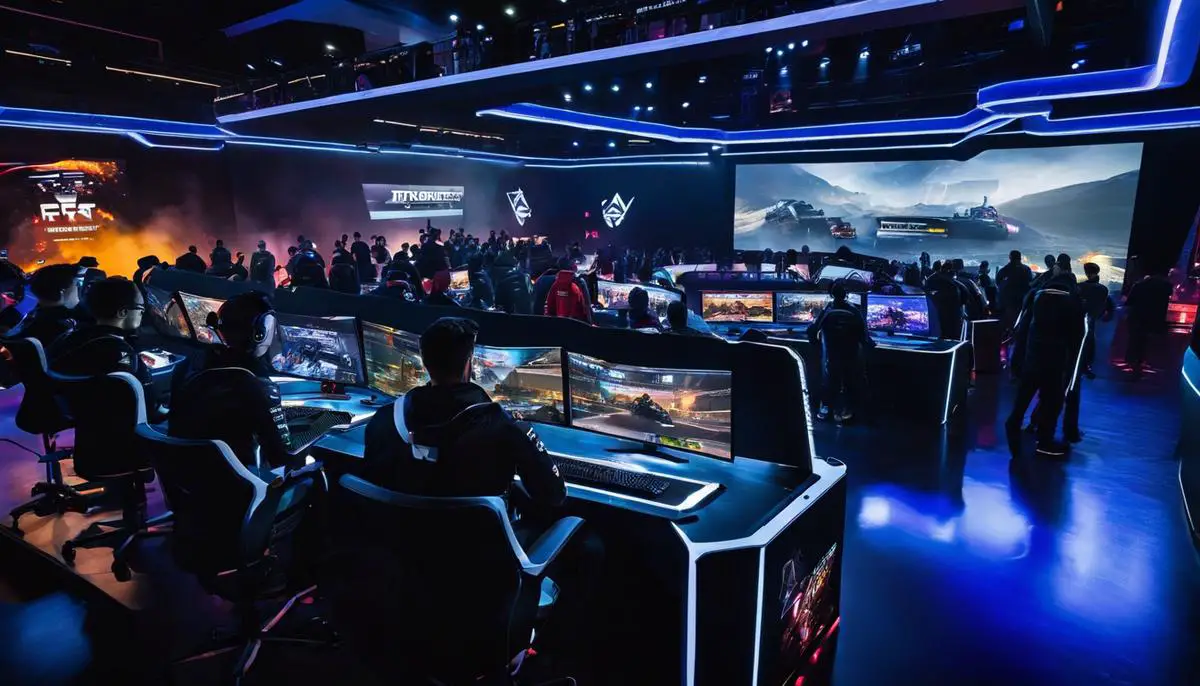The realm of competitive gaming, or eSports, has dramatically evolved over the past two decades and has increasingly garnered global attention. Large-scale eSports tournaments, like those for Call of Duty (CoD), have emerged as a testament to this revolution. Amid the adrenaline-thrusted competition, the critical and often overlooked role is played by the technology, which creates a seamless, immersive, and intense gaming atmosphere. From its humble beginnings, when paradoxically the consoles’ limited graphics and slow internet speeds didn’t dampen the spirits of enthusiasts, CoD eSports came a long way incorporating groundbreaking tech innovations. This essay provides a comprehensive examination of technology’s evolution and its profound influence on CoD eSports tournaments, explores the tech-side innovations, and extrapolates future tech trends’ impact on CoD eSports progression. Additionally, it delves into the indispensable role data analysis play in strategizing and enhancing player performance in CoD eSports.
Evolution of CoD eSports Tournaments
The evolution of technology can compare to the fast progress and development we see in the CoD (Call of Duty) eSports tournaments. What started as a simple idea to create competition among video gamers quickly ramped up with the advancement in technology.
In the early days, CoD eSports was a little more than a social gathering, where participants brought along their own gaming consoles. Things changed with the introduction of online gaming infrastructures that enabled tournament partners to host these competitions on a global stage. These online platforms introduced an entirely new level of competitiveness and accessibility that weren’t available in the brick and mortar style settings.
First online tournaments were barebones and had limited accessibility due to the vast disparities in internet speed, device capability, and lack of regulations. Those improvements in tech infrastructure alone catapulted the CoD eSports to the global eye. As the technology evolved, so did the structure of the CoD eSports tournaments.
Take, for example, the implementation of advanced matchmaking algorithms to ensure fair play. This adoption has improved the overall quality and integrity of competitive matches. Coinciding with technological advancements, Structured qualification rounds, segmented skill tiers, and international leagues have been etched into the tournament lineup, creating a clear pathway for players to go professional.
Additionally, the introduction of HD streaming technologies has propelled the spectatorship of CoD eSports. Services like Twitch and YouTube Gaming have emerged as industry leaders, hosting millions of views on tournament streams. This added an extra layer to the eSports tournaments, transforming them into a spectator sport as well as an intense competition.
The incorporation of analytical tools like eSports ecosystem analytics, computer vision, and machine-learning algorithms helps measure and improve player performance. These have augmented traditional coaching and strategy methods, signifying the importance of technology in eSports.
Furthermore, the leap from local multiplayer interactions to a seamless online multiplayer experience via dedicated servers has dramatically optimized the performance of the games, allowing for uninterrupted battles and fair play.
Nowadays, one major evolution is the increasing inclination towards mobile gaming. With CoD’s move into the mobile gaming sphere, technology’s impact on the tournament structure is more relevant than ever. It’s highly likely that we could witness global-scale eSports tournaments being conducted exclusively on mobile devices in the not-so-distant future.
In this light, technology and eSports go hand in hand. It’s become abundantly clear that without embracing and capitalizing on technological advancements, eSports tournaments would be running a fraction of their capabilities. Future developments in cloud gaming, AI, VR, and blockchain tech will further revolutionize these tournaments, and the CoD eSports will undoubtedly be at the forefront of this revolution.

Tech-side of CoD eSports Tournaments
Breaking Down the Tech that Powers CoD eSports Tournaments
The competitive gaming scene is constantly evolving, particularly when it comes to Call of Duty (CoD) eSports tournaments. These competitions have become increasingly sophisticated over time, utilizing some of the most cutting-edge technologies to ensure smooth and fair gameplay. Let’s delve into some of the contemporary technologies that have taken modern CoD eSports tournaments to new heights.
Augmented Reality (AR) and Virtual Reality (VR) have made massive strides in the eSports world, with CoD tournaments being no exception. These technologies heighten the gaming experience and create immersive atmospheres for both players and spectators. From the comfort of their homes, fans feel like they’re in the heart of the action, while players can navigate the battlefield as if they’re physically there.
Game engine advancements have also played a pivotal role in CoD eSports tournaments. Current engine technology enables ultra-realistic graphics, meticulous detail, and seamless gameplay, which significantly enhance competitors’ experience. Paired with state-of-the-art gaming peripherals and consoles, these advancements have helped tournaments evolve from just friendly matches to fully immersive competitive experiences.
Network infrastructure has also significantly improved, with Fiber Optic Internet access now customary at eSports events. This technology provides rapid, uninterrupted internet access, vital for multiplayer online gaming and live streaming. Also, with the emergence of 5G technology, online gaming and streaming quality are bound to reach unprecedented levels.
Dedicated servers for these tournaments have also become a norm, offering reliable, high-speed connections that reduce latency. With less lag, competitors have a fair, level playing field where victory truly hinges on their skills, not their connection speed.
Artificial Intelligence (AI) has also gained traction in eSports. In CoD tournaments, AI drives features like dynamic in-game coaching and real-time analytics. Dynamic coaching helps players adjust their strategies based on real-time gameplay, while analytics offer insights into competitors’ in-game behavior, an essential tool for pre-match strategizing and post-match debriefing.
Cloud technology is another key player, allowing convenient access to games from various devices, thus aiding in coordinating international tournaments. Also, game updates and patches can be seamlessly delivered, ensuring all competitors are on an even footing.
Finally, the advent of blockchain technology offers immense potential. It can facilitate secure and transparent transactions, be it registration fees, prize money, or in-game purchases. Moreover, it allows for the tokenization of in-game assets, providing players with ownership and control over their virtual belongings.
In conclusion, modern CoD eSports tournaments aren’t just about the skills of the players but also about the technology that powers them. This combination of talent and tech pushes the boundaries of what’s possible in eSports, crafting an experience that is immersive, fair, and exhilarating.

Impact of Future Tech Trends on CoD eSports
Utilizing Augmented Reality and Virtual Reality in CoD eSports will engineer a gaming revolution.
AR/VR allows spectators to view the game from a player’s perspective, making the viewing experience even more intense and vivacious.
This technology fosters a far deeper sense of immersion than traditional viewing methods.
With a VR headset and a haptic feedback suit, spectators will not simply observe but will truly feel every shot, explosion, and victory.
Upcoming game engine advancements are set to further enhance the gameplay experience by enabling more realistic physics, AI behavior, graphic fidelity, and environmental dynamics.
Real-time ray tracing, volumetric light, and particle effects will dramatically uplift the sense of reality in gaming.
This, in turn, will make high-intensity warfare in tournaments like CoD eSports more intuitive, responsive, and visually stunning, ultimately thrilling spectators and competitors alike.
Network infrastructure is vital to the gaming experience.
The introduction and expansion of Fiber Optic Internet and 5G technology can effectively obliterate latency issues.
Faster data transmission will ensure smoother, lag-free gameplay, providing a truly fair ground for combat in eSports.
Concurrently, it will also allow streaming technologies to broadcast tournaments in unprecedented quality, amassing a larger, more satisfied spectator base.
Dedicated servers will also play a crucial role in reducing latency and enhancing the gaming experience.
These servers can handle heavy traffic and offer seamless gameplay even during peak hours.
This will be a boon especially during live tournaments where thousands would tune in to spectate or participate, demanding a flawless gaming network infrastructure.
Artificial Intelligence is another groundbreaking development poised to reshape the landscape of CoD eSports tournaments.
AI’s potential to provide dynamic coaching and analytics can drastically improve player performance.
The convergence of AI and Machine Learning technology can decode player patterns and strategies, offering personalized training, skill enhancement and even predicting opponents’ moves.
The migration to cloud technology is another game-changer.
It eases the installation and update of games by eliminating the need to download hefty files, hence making access to games convenient.
Utilizing the cloud also makes it easier to rapidly roll out updates or new content ensuring every participant in a tournament is playing the most recent version.
Blockchain technology could potentially revamp the economic structure in gaming.
By enabling secure transactions, gamers can safely buy, sell, or trade in-game assets.
Also, this technology can facilitate smart contracts for eSports sponsorships, reward distribution, and even player contracts.
Applying blockchain technology could thereby stimulate a new ecosystem in CoD eSports where gamers can truly own their assets and earnings of their hard-fought victories.
In essence, future technological innovations align themselves promisingly to uplift the landscape of CoD eSports tournaments.
They are poised not only to elevate the gameplay experience but also to transform the financial, networking, and operational aspects of the game, bringing about comprehensive enhancements across the eSports spectrum.
This suggests a future where these developments become the norm and integral to the success of CoD eSports tournaments.

Data Analysis and Strategy in CoD eSports
The digital revolution has been pivotal to the eSports industry, and with Call of Duty (CoD) as one of its frontrunners, the blending of competitive gaming with technology has never been more apparent. From player training to fan engagement, advanced technologies are progressively transforming the landscape of CoD eSports.
Take wearable technology, for instance, which is implemented in the training regimes of eSports athletes. These gadgets analyze players’ physical and psychological responses during game play, revealing invaluable data on stress levels, heart rate, and reaction time. With this information, tailored training programs can be developed to optimize player performance. Additionally, these details provide insightful content for spectators, promoting a richer fan experience.
The recognition of the eSports industry has also led to the adoption of advanced 3D audio technologies. Spatial sound technology like Dolby Atmos is increasingly used to offer life-like audio experiences. In a game like CoD, having a realistic 360° sound environment can be the difference between victory and defeat. Moreover, it intensifies the viewing experience for spectators, adding another layer of engagement.
With the introduction of Data Analytics in CoD eSports, detailed records of every match are being used for strategic planning. These range from a player’s shooting accuracy to the time taken to complete objectives. Analyzing this data helps teams identify their strengths and weaknesses, thereby formulating more effective game strategies.
Technology is even impacting the rules of CoD tournaments. The introduction of sophisticated software, like cheat-detection algorithms, helps to ensure fair play. These systems monitor in-game activities for any abnormal patterns or behaviors that might indicate cheating, maintaining the integrity of the competition.
Big data also plays a crucial role in CoD eSports. With a colossal amount of data being constantly generated, data scientists can predict patterns and trends, allowing for enhanced strategic decision-making. Moreover, machine learning technology can process game data to predict player behavior, giving teams an upper hand.
As the eSports industry continues to grow, so does the demand for innovative technologies. Quantum computing, for example, with its unthinkable processing power, could revolutionize eSports by facilitating high-speed data processing and superior AI capacities.
Furthermore, the implementation of IoT devices in the gaming ecosystem will contribute to strategic formulation. IoT gaming devices can gather and analyze real-time data to provide inputs and offer immediate feedback based on gameplay.
While it’s impossible to accurately predict what the future holds for technology in CoD eSports, one thing is clear: the intersection of technology, data analysis, and strategic formulation will continue to be a driving force in transforming this digital sport. In this rapidly-evolving realm, keeping pace with technological innovations will always be an integral part of the game.

Few can deny that the next wave of breakthroughs in technology will undoubtedly recalibrate the landscape of CoD eSports. With prospective developments such as advanced VR and AR, Quantum Computing and Blockchain in the pipeline, the aspect of gaming and spectating could transform radically. Moreover, the ever-growing emphasis on data analysis, strategizing, and player development through cutting-edge technology showcases a new facet of professionalism in CoD eSports. The marriage of technological innovation with the human spirit of competition in CoD eSports reflects a symbiosis, which defines its evolution and lays down the trajectory for its future. Through a holistic understanding of this symbiosis, we can appreciate the subtleties and nuances of CoD eSports tournaments and look forward to an even more dynamic, immersive, and exhilarating future for eSports worldwide.
- Guide to Life Is Strange: True Colors Ch. 1 Choices - April 4, 2024
- Catching Spiritomb in Pokemon BDSP - April 4, 2024
- Mastering Life Is Strange: Key Choices in Chapter 1 - April 4, 2024
Views: 2









